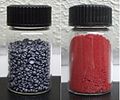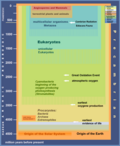Selenium (34Se) has six natural isotopes that occur in significant quantities, along with the trace isotope 79Se, which occurs in minute quantities in...
17 KB (980 words) - 23:16, 4 October 2024
isotopes primarily undergo beta plus decay to isotopes of arsenic, and isotopes heavier than the stable isotopes undergo beta minus decay to isotopes...
95 KB (10,959 words) - 22:18, 21 November 2024
Selenium-79 is a radioisotope of selenium present in spent nuclear fuel and the wastes resulting from reprocessing this fuel. It is one of only seven long-lived...
6 KB (585 words) - 18:58, 13 June 2024
Stable nuclide (redirect from Observationally stable isotope)
usually called that element's stable isotopes. The 80 elements with one or more stable isotopes comprise a total of 251 nuclides that have not been shown...
28 KB (3,289 words) - 18:41, 22 November 2024
Bromine (redirect from Biological roles of bromine)
than 79Br is electron capture to isotopes of selenium; that of isotopes heavier than 81Br is beta decay to isotopes of krypton; and 80Br may decay by either...
67 KB (7,719 words) - 23:39, 21 November 2024
This is a list of radioactive nuclides (sometimes also called isotopes), ordered by half-life from shortest to longest, in seconds, minutes, hours, days...
71 KB (304 words) - 19:31, 25 November 2024
Selone (category Selenium(−II) compounds)
selenoketone) is the structural analog of a ketone where selenium replaces oxygen. Selenium-77 is one of the isotopes of selenium that is stable and naturally occurring...
2 KB (234 words) - 16:22, 25 May 2024
Polonium (redirect from Compounds of polonium)
no stable isotopes, polonium is a chalcogen and chemically similar to selenium and tellurium, though its metallic character resembles that of its horizontal...
77 KB (8,400 words) - 23:53, 19 November 2024
more specific atoms with their isotopes. The reactant is then allowed to undergo the reaction. The position of the isotopes in the products is measured to...
42 KB (5,520 words) - 17:36, 14 August 2024
11 have 5 stable isotopes, 9 have 4 stable isotopes, 5 have 3 stable isotopes, 16 have 2 stable isotopes, and 26 have 1 stable isotope. Additionally, about...
37 KB (2,204 words) - 17:11, 25 March 2024
suspected. The method, which is sensitive to antimony, arsenic, bismuth, selenium, thallium and mercury, was discovered by Hugo Reinsch in 1841. Dissolve...
3 KB (267 words) - 13:05, 13 August 2024
Riley oxidation (redirect from Selenium dioxide oxidation)
The Riley oxidation is a selenium dioxide-mediated oxidation of methylene groups adjacent to carbonyls. It was first reported by Harry Lister Riley and...
8 KB (817 words) - 15:58, 26 September 2024
Unbibium (redirect from Isotopes of unbibium)
expected to fall within the range of the island of stability, potentially conferring additional stability on some isotopes, especially 306Ubb which is expected...
37 KB (7,066 words) - 16:08, 31 October 2024
David Catling (category University of Washington faculty)
a precursor to the rise of animal life. Catling proposed looking at oxygen-sensitive variations in stable isotopes of selenium to trace atmospheric and...
17 KB (2,009 words) - 21:40, 6 May 2024
Livermorium (redirect from History of livermorium)
because there are many reasonably long-lived isotopes of curium that can be used to make a target. The light isotopes can be made by fusing curium-243 with calcium-48...
55 KB (9,415 words) - 07:58, 3 November 2024
Chemical element (redirect from History of chemical elements)
isotope. Except for the isotopes of hydrogen (which differ greatly from each other in relative mass—enough to cause chemical effects), the isotopes of...
76 KB (10,055 words) - 09:18, 14 November 2024
Tungsten (redirect from Biological roles of tungsten)
of four stable isotopes (182W, 183W, 184W, and 186W) and one very long-lived radioisotope, 180W. Theoretically, all five can decay into isotopes of element...
83 KB (9,399 words) - 22:06, 18 November 2024
(35Br) has two stable isotopes, 79Br and 81Br, and 35 known radioisotopes, the most stable of which is 77Br, with a half-life of 57.036 hours. Like the...
22 KB (1,324 words) - 12:03, 10 October 2024
Great Oxidation Event (redirect from Lomagundi–Jatuli isotope excursion)
B.M.; et al. (1 August 2015). "The evolution of the global selenium cycle: Secular trends in Se isotopes and abundances". Geochimica et Cosmochimica Acta...
85 KB (9,539 words) - 09:00, 3 November 2024
Tennessine (redirect from History of tennessine)
half-lives exceeding the age of the universe for the heaviest isotopes like 335Ts when beta decay is not considered. Lighter isotopes of tennessine may be produced...
69 KB (11,034 words) - 20:20, 25 November 2024
Iodine (redirect from Source of iodine)
non-toxic radiocontrast material. Because of the specificity of its uptake by the human body, radioactive isotopes of iodine can also be used to treat thyroid...
104 KB (11,657 words) - 19:32, 24 November 2024
Unbiunium (redirect from Isotopes of unbiunium)
Should the synthesis of unbiunium isotopes in such a reaction be successful, the resulting nuclei would decay through isotopes of ununennium that could...
36 KB (7,381 words) - 16:07, 31 October 2024
Tellurium (redirect from History of tellurium)
silver-white metalloid. Tellurium is chemically related to selenium and sulfur, all three of which are chalcogens. It is occasionally found in its native...
61 KB (6,969 words) - 09:04, 25 November 2024
Flerovium (redirect from History of flerovium)
synthesis or through radioactive decay of even heavier elements, and all known isotopes are short-lived. Six isotopes of flerovium are known, ranging in mass...
74 KB (12,046 words) - 09:10, 25 November 2024
Uranium (redirect from History of uranium)
trace isotopes 237U and 239U exclusively undergo beta decay, with respective half-lives of 6.752 days and 23.45 minutes. In total, 28 isotopes of uranium...
110 KB (12,380 words) - 11:06, 17 October 2024
Astatine (redirect from History of astatine)
all its isotopes have half-lives of 8.1 hours or less, decaying into other astatine isotopes, bismuth, polonium, or radon. Most of its isotopes are very...
82 KB (9,296 words) - 09:26, 25 November 2024
Darmstadtium (redirect from History of darmstadtium)
occurring isotopes. Several radioactive isotopes have been synthesized in the laboratory, either by fusing two atoms or by observing the decay of heavier...
39 KB (7,374 words) - 17:05, 18 November 2024
Neon (redirect from History of neon)
spectroscope. Stable isotopes of neon are produced in stars. Neon's most abundant isotope 20Ne (90.48%) is created by the nuclear fusion of carbon and carbon...
32 KB (3,847 words) - 14:31, 23 November 2024
Nihonium (redirect from History of nihonium)
of 282113 were detected. The aim of this experiment had been to synthesise the isotopes 281113 and 282113 that would fill in the gap between isotopes...
92 KB (13,693 words) - 09:28, 25 November 2024











